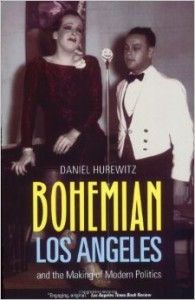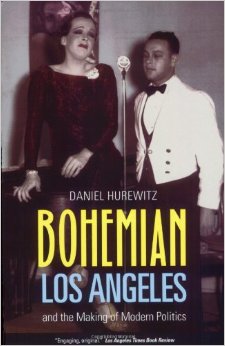 Bohemian Los Angeles and the Making of Modern Politics
Bohemian Los Angeles and the Making of Modern Politics
by Daniel Hurewitz
University of California Press. 377 pages, $29.95
FOR ANGELENOS in the know, Hollywood is nothing more than a neighborhood, one not nearly as interesting as Silver Lake or Echo Park. In the first half of the 20th century, this hilly enclave just north of downtown L.A. was known as Edendale, although sometimes it was “Mount Moscow,” or the “Swish Alps.” In Bohemian Los Angeles and the Making of Modern Politics, Daniel Hurewitz reconstructs the world of Edendale’s gay men, artists, and leftists, and sketches the origins of modern identity politics.
The story begins with two men who lived at the top of a hill near the Silver Lake Reservoir.
It didn’t start out that way. As Los Angeles men of the early 20th century publicly expressed same-sex desires in downtown Pershing Square or at the bathhouses of Long Beach, their visibility sparked increased attention from authorities. Along with that scrutiny came the need, in courtrooms and newspaper interviews, for men who experienced same-sex desire to start to name themselves. When they did, Hurewitz shows, they didn’t describe a fixed essence. Like Julian Eltinge’s playful, gender-bending stage act, identities were in motion, and they rarely added up to anything collective. If men increasingly knew where to go for sex, they had little idea where to go for community.
Artists and Communists found each other more easily, drawn to L.A.’s culture industry, good weather, and cheap rents. In Edendale, an enclave that offered what Hurewitz evocatively calls “the lure of shared isolation,” artists formed self-conscious communities. Gone was the generation of the dandy; in the 1930’s, serious modernists delved into the inner self. Digging through their poems, sketchbooks, and book collections, Hurewitz suggests that their real contribution was the creation of a new culture. Edendale also housed many of the city’s Communists, who were on the front lines of city politics during the Great Depression. They too formed communities in Edendale based on chosen ties, and just as importantly, they built a culture that recognized no boundaries between public and private. “Everything,” recalled one Party member, “was a revolutionary act.”
Bohemian L.A. was linked not only by the ties between its enclaves—artists, Communists, homosexuals—but in the official mind as well. In the book’s best chapter, Hurewitz shows how Depression-era authorities collapsed the distinctions between radicalism, perversion, and the avant-garde. In 1937, Mayor Frank Shaw, fighting off a recall attempt, launched an investigation of “degenerates”; and while the 1930’s sex panic eventually faded, state surveillance and incarceration continued. When Julian Eltinge, down on his luck, attempted a comeback in 1940, he confronted a new law banning female impersonators. “Any place where that type congregates should not have a permit,” grumbled the L.A. police chief, suggesting an understanding of identity far more fixed than that of a generation before.
Sexual minorities defended themselves with some of the same tools that Communists had used for decades. But Hurewitz rejects simple explanations. “Oppression alone did not call homosexual politics into being,” he notes. Rather, it was the convergence of social and cultural changes that remade political life. “The interior life of emotions and desires was no longer simply a cultural concern; it now carried social and political significance.” Early Mattachine Society politics connected with the struggles of the rest of bohemian Los Angeles: Mattachine’s 1952 campaign against police entrapment drew rhetorically from Communist thinking and built institutionally on the city’s multiracial progressive politics. (All the more ironic, then, that Harry Hay’s fellow CP members pressured him to resign in 1953, worried that his gay activism would threaten the Party.)
Hurewitz powerfully reminds us that gay communities have rarely developed without allies. The gay men (and lesbians, not much studied in Bohemian Los Angeles) who congregated in Edendale depended on each other, but they also needed artists, Jews, Communists, the disabled, and loners of all stripes. These days, Silver Lake and Echo Park still feel artsy, lefty, and sexually diverse, but with the average home price hovering near a half million dollars, that bohemianism rings a hollow note. And therein lies Bohemian Los Angeles’ implicit lesson for people today who care about what’s happening to neighborhoods like Silver Lake. What made Edendale distinctive wasn’t the simple fact of the mixing. What mattered was the pursuit of something truly alternative.
Christopher Capozzola teaches American history at MIT.






